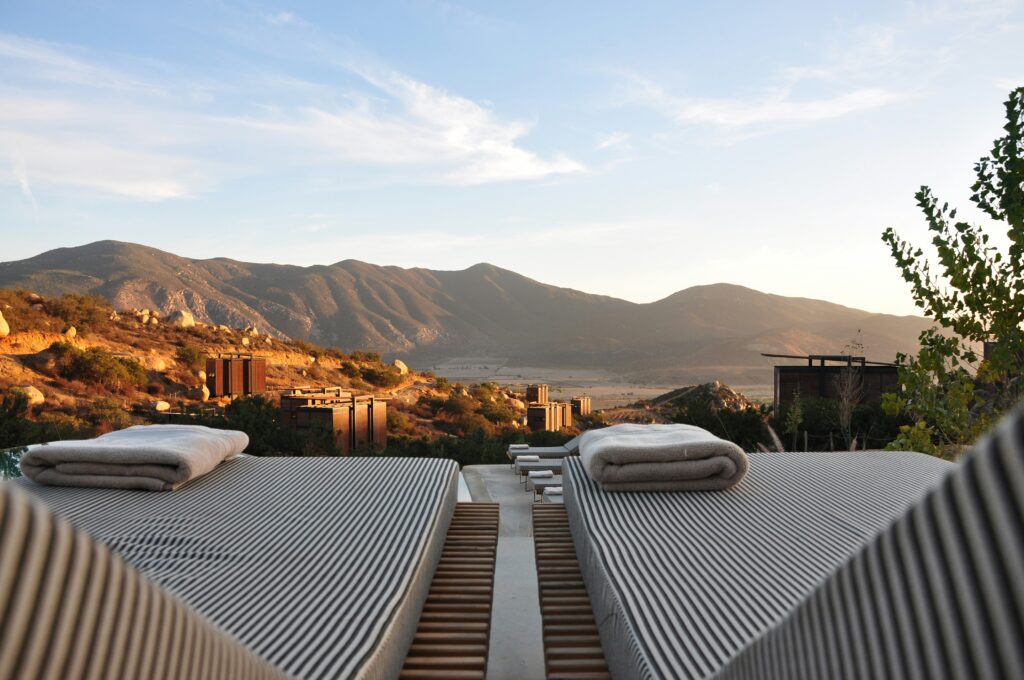Introduction to the history of hotels and resorts
Step into the realm of hospitality, where history intertwines with modern marvels. Journey with us as we unveil the captivating evolution of hotels and resorts, from humble beginnings to extraordinary heights. Prepare to be immersed in a world where grandeur meets comfort, tradition meets innovation, and impeccable service reigns supreme. Join us on this behind-the-scenes exploration as we uncover the remarkable transformation that has shaped the way we experience luxury today. Buckle up and get ready for a riveting ride through time!
Early forms of lodging and accommodations
The history of lodging and accommodations dates back to ancient times when travelers sought shelter and rest during their journeys. In these early days, options were limited, and basic forms of lodging emerged to meet the needs of weary travelers.
One common form was the inn, which provided a place for travelers to eat, sleep, and stable their horses. These inns were often located along popular trade routes or near important landmarks such as monasteries or castles. They offered simple rooms with shared facilities and a hearty meal for those passing through.
For those who couldn’t afford an inn, there were also taverns that provided communal sleeping quarters where guests could lay their heads for a small fee. These taverns often catered to merchants and tradespeople looking for affordable accommodations while conducting business away from home.
In rural areas, farmhouses would sometimes offer lodgings to wayfarers in exchange for labor or goods. Travelers would have the opportunity to experience life on a working farm while enjoying some comfort and respite from their journey.
As civilizations advanced, so did the concept of hospitality. Wealthy individuals began building private estates that served as both residences and places of entertainment for guests. These grand buildings became known as mansions or manor houses, offering luxurious accommodations with elaborate furnishings and exquisite cuisine.
While early forms of lodging may seem rudimentary by today’s standards, they laid the foundation for what would later become modern hotels and resorts. Each step in this evolution brought new innovations in design, amenities, services, providing ever-increasing levels of comfort and luxury.
Stay tuned as we continue our behind-the-scenes exploration into the fascinating evolution of hotels And resorts!
The rise of luxury hotels in the 19th century
The 19th century marked a turning point in the hotel industry, with the rise of luxury hotels transforming the way people experienced travel and hospitality. These opulent establishments offered an escape from the ordinary, catering to the needs and desires of discerning travelers.
With their grand facades and intricate architecture, luxury hotels became symbols of prestige and social status. They were adorned with lavish furnishings, ornate chandeliers, and plush carpets that exuded elegance at every turn. The rooms themselves were spacious and well-appointed, equipped with modern amenities like running water, heating systems, and private bathrooms – a far cry from earlier accommodations.
These hotels also boasted top-notch service that was unparalleled at the time. Guests were treated like royalty by attentive staff who catered to their every whim. From personalized concierge services to fine dining experiences prepared by renowned chefs, no detail went unnoticed in providing utmost comfort and satisfaction.
Furthermore, these luxury establishments pioneered innovations such as electric lighting systems and elevators – technological advancements that further enhanced guests’ experiences during their stay.
As travel became more accessible to a larger segment of society in later years of this era due to improved transportation networks, luxury hotels expanded both geographically and conceptually. They began popping up in major cities around the world as well as popular tourist destinations offering unique experiences tailored to different types of travelers – be it business executives seeking sophisticated meeting spaces or leisure tourists looking for relaxation amidst luxurious surroundings.
In essence, the rise of luxury hotels during this period set new standards for hospitality excellence that continue to shape our expectations today. It laid down foundations for what we now consider essential components of high-end accommodations: impeccable service delivery combined with exceptional comfort surrounded by tasteful aesthetics.
The legacy left behind by these pioneering establishments continues to influence contemporary hotel design concepts – reminding us how far we have come while inspiring continuous innovation within the ever-evolving landscape of hospitality.
Impact of World Wars on the hotel industry
World Wars I and II had a profound impact on the hotel industry, reshaping it in ways that would have long-lasting effects. During both wars, many hotels were repurposed to serve as military hospitals or headquarters for the armed forces. This led to a decline in tourism and a disruption of normal operations.
The destruction caused by the wars also took its toll on hotels and resorts located in war-torn areas. Many iconic properties were damaged or destroyed during bombings, leaving behind only remnants of their former glory. The rebuilding process took years, if not decades, delaying the recovery of the hospitality sector.
Additionally, travel restrictions imposed during wartime further hindered the growth of hotels and resorts. With limited transportation options and safety concerns prevailing, people were less inclined to travel for leisure purposes.
However, there was one positive outcome from these challenging times: advancements in technology accelerated due to wartime needs. Hotels began embracing modern conveniences such as air conditioning systems and telephones in rooms. These improvements not only enhanced guest comfort but also set new standards for luxury accommodation.
World Wars I and II had a significant impact on the hotel industry worldwide. While they brought about temporary setbacks with disruptions and destructions, they ultimately paved the way for innovation and progress in terms of design and amenities offered by hotels today
Post-war developments and the introduction of resorts
Post-war developments brought significant changes to the hospitality industry, paving the way for the introduction of resorts. As travel became more accessible and people sought relaxation and leisure after years of turmoil, resorts emerged as a popular choice for vacationers.
These new destinations offered an escape from reality, with sprawling grounds, stunning landscapes, and a wide range of amenities. Resorts were designed to cater to guests’ every need, providing luxurious accommodations and various recreational activities such as golf courses, swimming pools, and spa facilities.
One notable post-war development was the rise of all-inclusive resorts. This concept allowed guests to pay a fixed price upfront that covered accommodation, meals, drinks, and entertainment. It revolutionized the travel industry by simplifying budgeting for travelers while offering convenience and value.
Resorts also embraced unique architectural designs during this time. Modernist styles became popular choices as architects experimented with innovative ideas that blended harmoniously with natural surroundings. Many resorts aimed to create an immersive experience where visitors could truly disconnect from their daily lives.
The 1950s witnessed further growth in resort tourism as air travel became more affordable and widespread. Tropical destinations like Hawaii and Caribbean islands attracted sun-seeking tourists who flocked to beachfront resorts dotted along pristine coastlines.
Post-war developments marked a pivotal moment in hotel history as they introduced the world to magnificent resorts that combined luxury with escapism. These havens continue to evolve today but remain true to their purpose: providing travelers with unforgettable experiences in idyllic settings.
Changes in design and amenities over time
Changes in design and amenities have been a constant theme throughout the evolution of hotels and resorts. In the early days, accommodations were basic and focused solely on providing a place for travelers to rest. However, as time went on, hotels began to prioritize comfort and luxury.
One significant change was the introduction of private bathrooms in hotel rooms. In the past, guests often had to share communal facilities or rely on chamber pots. The addition of en-suite bathrooms revolutionized hospitality by offering privacy and convenience.
Another notable development was the integration of technology into hotel design. Today, it’s common to find smart rooms equipped with automated features such as keyless entry systems, temperature control panels, and voice-activated assistants. These advancements not only enhance guest experiences but also streamline operations for hotel staff.
In terms of aesthetics, hotels have evolved from simple structures into architectural marvels that serve as landmarks themselves. From grand Victorian-era buildings adorned with ornate details to sleek contemporary designs featuring glass facades and innovative shapes, hotels now strive to make a visual statement that reflects their unique brand identity.
Amenities have also adapted over time to meet changing guest expectations. While once considered luxuries reserved for high-end establishments, features like swimming pools, spas, fitness centers, restaurants offering diverse cuisines are now commonplace in many hotels across all price ranges.
Moreover,email email-marketing campaigns social-media presence have become crucial tools for attracting guests in today’s digital age.
Guests now expect seamless connectivity whether they’re traveling for business or pleasure.
Hotels are adapting by implementing robust Wi-Fi networks and providing charging stations throughout their properties.
Social media platforms allow them both interact directly with potential customers.
Innovations like virtual reality tours enable prospective guests get immersive experience before even setting foot inside establishment
Designing sustainable spaces has also gained importance.
With increasing concern about environment,hotel industry is embracing eco-conscious practices.
Most modern properties incorporate energy-efficient lighting systems,waste management programs, and use of eco-friendly materials in construction.
This commitment to sustainability not only benefits
Current trends in the hotel and resort industry
Current Trends in the Hotel and Resort Industry
As we step into a new decade, the hotel and resort industry continues to evolve at a rapid pace. With changing consumer preferences and advancements in technology, hotels and resorts are constantly adapting to stay ahead of the curve. Let’s take a closer look at some of the current trends shaping this ever-changing landscape.
Sustainability has become a major focus for many hotels and resorts. Guests are increasingly conscious about their environmental impact, leading to an increased demand for eco-friendly accommodations. From implementing energy-saving practices to using sustainable materials, hotels are finding creative ways to reduce their carbon footprint.
Another trend gaining traction is personalized experiences. Today’s travelers seek unique and tailored experiences that go beyond cookie-cutter hospitality. Hotels are going above and beyond by offering customized amenities, personalized services, and curated packages that cater to individual needs and preferences.
Technology also plays a significant role in shaping the industry today. Seamless check-in processes through mobile apps or self-service kiosks have become commonplace in many establishments. Additionally, smart room features like voice-controlled devices provide guests with convenience at their fingertips.
Wellness tourism has seen tremendous growth in recent years as more people prioritize their physical and mental well-being during travel. Hotels now offer state-of-the-art fitness centers, spa facilities, yoga classes, healthy dining options, and even wellness retreats designed specifically for rejuvenation.
Furthermore, experiential travel has emerged as a popular trend among modern-day explorers who crave authentic local encounters rather than just ticking off tourist attractions from their list. Many hotels now collaborate with local experts to curate immersive activities such as cooking classes with renowned chefs or guided tours led by historians.
Lastly but certainly not least – social media influences every aspect of our lives today – including our travel decisions! Hotels recognize the power of social media platforms like Instagram for brand exposure; hence they invest heavily in creating visually appealing spaces that will entice guests to capture and share their experiences online.
The hotel and resort
Future outlook for hotels and resorts
The future of hotels and resorts holds exciting possibilities, driven by advancements in technology and changing consumer preferences. As we look ahead, one trend that is likely to shape the industry is personalization. Guests are seeking customized experiences tailored to their individual needs and desires.
Smart technology will play a crucial role in delivering these personalized experiences. Hotels may incorporate features such as voice-activated rooms, smart mirrors with augmented reality capabilities, and personalized virtual assistants to enhance guest comfort and convenience.
Sustainability will also be a key focus for hotels and resorts in the future. With growing concerns about climate change, eco-friendly practices will become standard across the industry. From energy-efficient buildings to waste reduction initiatives, hotels will strive to minimize their environmental impact while providing exceptional service.
Another area of growth is wellness tourism. As people prioritize health and well-being, hotels will expand their offerings beyond fitness centers to include spa services, healthy dining options, meditation spaces,and outdoor activities like yoga retreats or nature walks.
In addition, experiential travel will continue to gain popularity. Guests want immersive experiences that go beyond just staying at a hotel – they want opportunities for cultural immersion and connection with local communities through activities like cooking classes or guided tours led by locals.
Lastly,the rise of alternative accommodations platforms has revolutionized the way people book accommodations.
The sharing economy model offered by companies like Airbnb has disrupted the traditional hotel industry.
Hotels may need to adapt by offering unique amenities or partnering with local businesses,to provide guests with an authentic experience that cannot be replicated elsewhere.
The future outlook for hotels and resorts is undoubtedly dynamic.
It’s an era where innovation,flexibility,and adaptability are paramount.
Successful establishments that embrace these changes are poised for success,tapping into new markets,and creating unforgettable experiences for guests worldwide
Conclusion: The transformation of hospitality throughout history
Conclusion: The Transformation of Hospitality Throughout History
As we conclude our journey through the evolution of hotels and resorts, it becomes apparent that the hospitality industry has witnessed remarkable transformations over time. From humble lodgings to grand luxury hotels, from the impact of world events to the introduction of modern amenities and design, hotels and resorts have continuously adapted to meet the changing needs and desires of travelers.
Throughout history, one thing remains constant – the desire for comfort, convenience, and a memorable experience. Today’s travelers are looking for more than just a place to rest their heads; they seek personalized service, unique experiences, and sustainable practices. Hoteliers around the world are rising up to this challenge by offering innovative services such as wellness programs, eco-friendly initiatives, immersive cultural activities, and cutting-edge technology.
Looking into the future, there is no doubt that hotels and resorts will continue to evolve in response to emerging trends. We can expect advancements in artificial intelligence (AI) integration for enhanced guest experiences as well as increased focus on sustainability with eco-friendly designs becoming mainstream.
As we move forward into this new era of hospitality innovation alongside societal changes driven by globalization and technological advancements. One thing is clear – whether you’re stepping back in time at a historical landmark or indulging in contemporary luxury at a modern marvel resort – accommodation providers will always strive to create unforgettable memories for guests from all walks of life.
So next time you check-in at your favorite hotel or explore an exotic resort paradise remember – behind every door lies centuries worth of transformation shaping today’s unparalleled accommodations industry! Embrace these evolutions as they continue unfolding before our very eyes!
Safe travels!







